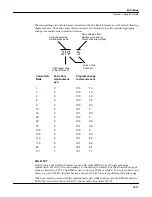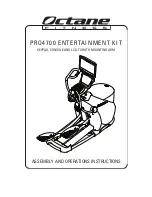
MIDI Mode
The Receive (RECV) Page
10-5
sequence, for example, if you’re driving your K2500 from one of Roland’s hardware
sequencers. Setting this parameter to Ignore will take care of this problem.
Regardless of the setting for this parameter, the K2500 will always respond to its own Panic
button by shutting off all active notes and controllers.
Program Change Type (ProgChgType)
This determines how the K2500 will respond to program change commands received via MIDI.
The value of this parameter automatically matches the value of PChgType on the XMIT page;
changing it on one page will change it on the other. See “Program Change Formats” at the end
of this chapter for an explanation of the various values available for this parameter.
Velocity Map—Receive
The velocity map applies a preset curve to incoming velocity messages. It maps incoming
velocity levels to new levels that correspond to the eight dynamic levels used by the VTRIGs
and keymaps for velocity level selection. See Chapter 17. Normally you’ll leave this set to
1 Linear. Adjust this parameter’s value only when you need to alter the K2500’s response to the
velocity messages from your MIDI controller, for example, if you’re getting too much or too
little volume when you play, or when you’re using a sequencer to drive the K2500.
Pressure Map—Receive
Like the velocity map, this determines how the K2500 responds to incoming pressure
(aftertouch) messages.
System Exclusive ID (SysExID)
The SysExID parameter differentiates between more than one MIDI device of the same model.
You won’t need to change the default setting of 0 unless you have multiple K2500s receiving
SysEx messages from a single source. In that case, make sure each K2500 has a different
SysExID. Then you can direct SysEx messages to the appropriate K2500 with the SysExID byte
that’s included with every SysEx message. A value of 127 specifies “Omni Receive.” That is, at
this value, a K2500 will respond to a SysEx message regardless of the SysEx ID of the message
(as long as the manufacturer and device IDs match—see the
Reference Guide
for more
information on System Exclusive messages).
SCSI ID
Use this parameter to change the SCSI ID of your K2500. You can ignore this parameter unless
you’ve connected a SCSI device (external SCSI disk or CD-ROM drive) to the K2500’s SCSI
port. You can use either or both SCSI ports to chain up to seven SCSI devices to the K2500 (a
total of eight devices can be chained together); just be sure to set each one to a different SCSI ID.
Most SCSI devices available today make it easy to change their SCSI IDs, so you may not have
to adjust this parameter even if you have several SCSI devices connected. See Chapter 13 for
more information about using SCSI devices.
Bend Smooth
This parameter can improve your K2500’s performance when you’re driving it from a MIDI
guitar controller. Its default value is On.
You may find that pitch bending seems to carry over from the previous note to the next note,
causing it to start on the wrong pitch. This is probably due to the automatic pitch smoothing
provided by the K2500. If this is happening, try setting the BendSmooth parameter to a value of
Off.




































